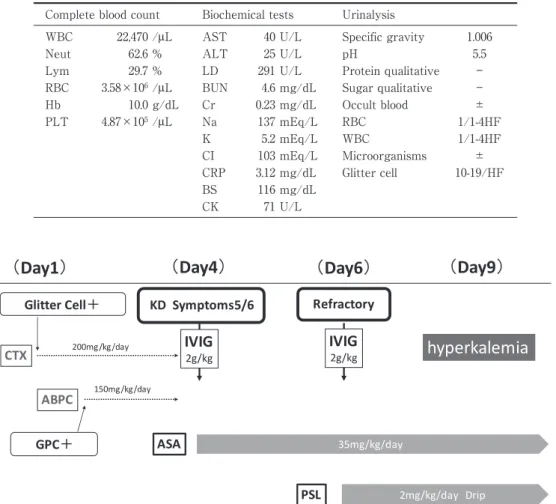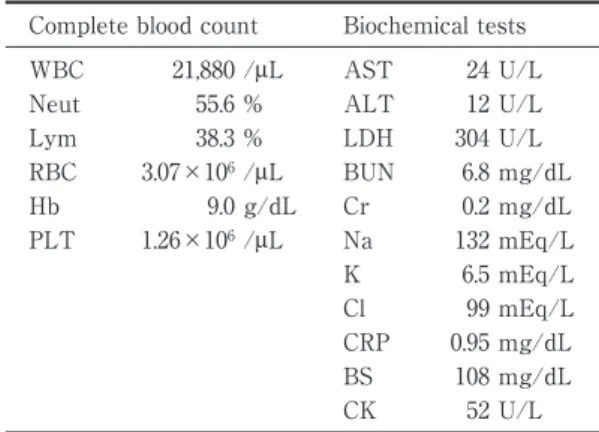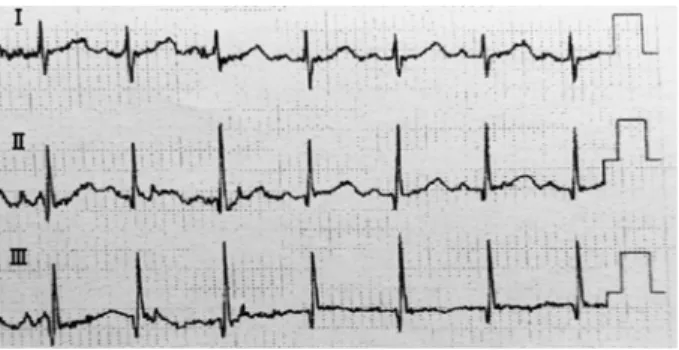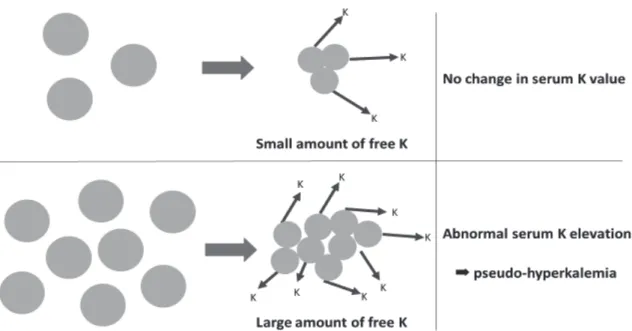報 告 東女医大誌 89(1): 7-12, 2019.2
川崎病の治療経過中に認められた偽性高カリウム血症の 1 乳児例
東京女子医科大学医学部小児科学教室 スギモト ケイ チ バ ユキヒデ カブラキヨウイチロウ 杉本 圭・千葉 幸英・鏑木陽一郎 カ ネ コ ヒロタカ ツ ル タ トシヒサ ナ ガ タ サトル 金子 裕貴・鶴田 敏久・永田 智 (受理 2018 年 11 月 14 日)Pseudo-hyperkalemia Obverted in a Patient with Kawasaki Disease during Treatments Kei Sugimoto, Yukihide Chiba, Yoichiro Kaburaki,
Hirotaka Kaneko, Toshihisa Tsuruta, and Satoru Nagata Department of Pediatrics, Tokyo Women s Medical University, Tokyo, Japan
A 3-month-old girl was diagnosed with Kawasaki disease 4 days after onset and intravenous immunoglobulin (IVIG) treatment was started on the same day. Because IVIG therapy was ineffective, a combination of IVIG and prednisolone was administered on day 6. On day 9, the patient had hyperkalemia (6.5 mEq/L) without electrocar-diographic abnormalities. The serum potassium level measured in blood collected in heparinized tubes was within normal range. We diagnosed pseudohyperkalemia leading to leukocytosis and thrombocythemia, attribut-able to coagulation system activation and increased release of potassium from leukocytes and/or platelets. Serum potassium levels in patients with potential hyperkalemia under these conditions may require greater considera-tion.
Key Words: Kawasaki disease, pseudo-hyperkalemia
緒 言 一般に偽性高カリウム(K)血症は,「血清 K 値が 血漿 K 値よりも 0.4 mmol/l 以上高い場合」と定義さ れる1)2) .偽性高 K 血症の要因としては,検体の保存 時の溶血,免疫学的機序を介した細胞破壊による溶 血,掌のクレンチング(手を開いて再び握る動作)に よる機械的溶血3)4) 等が知られている.その他,白血球 数,血小板数の増加も偽性高 K 血症を来すことがあ るが,前述の 3 つの要因と比べて知られていない. 今回,我々は川崎病の治療経過中に認められた白血 球数,血小板数の増加による偽性高 K 血症の 1 乳児 例を経験したので報告する. 症 例 患者:生後 3 か月の女児. 主訴:発熱. 家族歴:父には川崎病の既往あり.他に特記事項 なし. 出生歴:在胎 38 週 5 日に骨盤位のため帝王切開 にて出生,その他周産期異常指摘なし 既往歴:特記事項なし. 現病歴:前日より不機嫌,哺乳量低下の症状が あったが,38.7℃ の発熱を認めたため当院を受診し :杉本 圭 〒162―8666 東京都新宿区河田町 8―1 東京女子医科大学医学部小児科学教室 Email: sugimoto.kei@twmu.ac.jp doi: 10.24488/jtwmu.89.1_7
Copyright Ⓒ 2019 Society of Tokyo Women s Medical University. This is an open access article distributed under the terms of Creative Commons Attribution License (CC BY), which permits unrestricted use, distribution, and reproduction in any medium, provided the original source is properly credited.
Figure 1 Clinical course.
Although we started treating the urinary tract infection from the first hospital day, 5 of the 6 symptoms of Kawasaki disease (ocular conjunctival congestion, redness of the oro-pharyngeal mucosa, irregular rash, rigid edema, neck lymphadenopathy) appeared on hos-pital Day 4. Kawasaki disease was diagnosed on that day, and we therefore changed the treatment regimen. Because the first intravenous immunoglobulin (IVIG) administration was ineffective, combination therapy with IVIG and prednisolone was performed from Day 6 onward. Although the symptoms of Kawasaki disease showed improvement, blood tests revealed hyperkalemia on Day 9.
KD, Kawasaki disease; ASA, Acetylsalicylic acid; GPC, Gram positive coccus; CTX, cefo-taxime; ABPC, ampicillin; PSL, prednisolone; IVIG, intravenous immunoglobulin.
Table 1 Laboratory findings (Day1 L/D).
Complete blood count Biochemical tests Urinalysis
WBC 22,470 /μL AST 40 U/L Specific gravity 1.006 Neut 62.6 % ALT 25 U/L pH 5.5 Lym 29.7 % LD 291 U/L Protein qualitative ― RBC 3.58×106/μL BUN 4.6 mg/dL Sugar qualitative ― Hb 10.0 g/dL Cr 0.23 mg/dL Occult blood ± PLT 4.87×105/μL Na 137 mEq/L RBC 1/1-4HF K 5.2 mEq/L WBC 1/1-4HF CI 103 mEq/L Microorganisms ± CRP 3.12 mg/dL Glitter cell 10-19/HF BS 116 mg/dL CK 71 U/L た(第 1 病日).来院時明らかな脱水所見は認めな かったが,咳嗽および鼻汁を認めた.月齢を考慮し, 同日精査加療目的に入院となった. 入院時現症:身長 58.1 cm(−0.9 標準偏差:SD), 体重 6.1 kg(+0.2 SD),頭囲 39.1 cm(−0.3 SD),胸 囲 40.7 cm(+0.5 SD)と体格は年齢相当であった. 意識清明,体温 38.9℃,脈拍数 160 回/分,呼吸数 36 回/分,咽頭発赤があり,聴診上呼気時に高調性喘鳴 が聴取された.他に,明らかな理学的,神経学的な 異常所見は認められなかった. 入院時検査(Table 1)では好中球有意の白血球数 の上昇(白血球数 22,470/μL,好中球 62.6%),C 反応 性 タ ン パ ク 質(C-reactive protein:CRP)の 上 昇 (3.12 mg/dl),軽度の血清 K 値の上昇(5.2 mEq/L) が認められた.尿沈査では glitter cell(10-19/HF), 尿潜血が認められた.その他,尿定性検査では異常 を認めず,髄液検査でも特記すべき所見は認めな かった. 入院後の経過(Figure 1): 臨床経過より上気道炎と判断したが,入院時尿所 見より細菌性尿路感染症の併存が疑われ,セフォタ キシム 200 mg/kg/day 点滴静注投与を開始とした.
Figure 2 Correlation of white blood cell and platelet counts with serum potassium level. This table shows the changes in white blood cell counts, platelet counts, and potassium (K) levels in peripheral blood. The normal upper limit of K is indicated by a dotted line. The tripartite values rise significantly through Day 9.
WBC, White blood cells; K, Potassium; PLT, Plateletes thrombocytes. Table 2 Laboratory findings (Day9 L/D).
Complete blood count Biochemical tests WBC 21,880 /μL AST 24 U/L Neut 55.6 % ALT 12 U/L Lym 38.3 % LDH 304 U/L RBC 3.07×106/μL BUN 6.8 mg/dL Hb 9.0 g/dL Cr 0.2 mg/dL PLT 1.26×106/μL Na 132 mEq/L K 6.5 mEq/L Cl 99 mEq/L CRP 0.95 mg/dL BS 108 mg/dL CK 52 U/L 翌日解熱傾向はなく,入院時の尿培養からグラム陽 性球菌(Gram positive cocci:GPC)が検出され,第 2 病日よりアンピシリン 150 mg/kg/day 点滴静注 投与を開始とした.しかし,同日より両側眼球結膜 充血,体幹を中心とした不定形皮疹の出現を認めた. 第 4 病日に臨床症状として,口腔咽頭粘膜の発赤, 眼球結膜充血,口腔咽頭粘膜の発赤,手・足背の硬 性浮腫,頸部リンパ節腫脹が加わった事から川崎病 と診断し,γ グロブリン大量静注療法(intravenous immunoglobulin:IVIG)2 g/kg および,アセチルサ リチル酸 35 mg/kg/day の経口投与を開始した.そ の後,一旦解熱傾向が認められたが,第 6 病日に再 び発熱を認めた事から,IVIG 不応例として IVIG 再投与に加えプレドニゾロン 2 mg/kg/day の経口 投与を行った.以後,川崎病の諸症状は改善を認め たが,第 9 病日の血液生化学検査にて血清 K 値が 6.5 mEq/L と高値を認めた(Table 2).なお,採血検 体に溶血は認めなかった.末梢血白血球数と血小板 数も第 9 病日に上昇していた(Figure 2). 高 K 血症の原因として,横紋筋融解症,糖尿病等 による細胞内からの K の遊離,急性腎不全,副腎不 全などによる K の排出障害,白血球数や血小板数増 加に伴う偽性高 K 血症などの可能性を考え,各種血 液検査,血液ガス分析,尿検査等を行った.第 9 病 日の血液生化学検査(Table 2)にて,血液尿素窒素, クレアチニン(Cr),血糖値の有意な上昇はなく, LDH,AST,ALT 等の逸脱酵素数の上昇も認めな かった.同日施行した静脈血液ガス分析検査の所見 では,大気圧条件下で pH 7.45,PCO234.2 mmHg,
HCO3−23.7 mmol/L,K 5.55 mmol/L であり,異常所
見は認めなかった.心電図所見においては,心拍 168 回/分,洞調律で,電気軸は正,ST-T 変化なく,T 波増高は認めなかった(Figure 3).尿検査では K 27 mg/dl,Cr 12 mg/dL,尿中 β2MG(macroglobu-lin)220μg/L(基 準 値:≦230 μg/L),浸 透 圧 312 mOsm/Kg・H2O であった.この事より,急性腎不全
Figure 3 Electrocardiographic findings Day 9.
Electrocardiography revealed a heart rate of 168 bpm, si-nus rhythm, no significant ST-T change, and no significant tented T wave. These findings confirm the absence of any obvious hyperkalemia.
による高 K 血症は否定的であった.血漿浸透圧は 282 mOsm/Kg・H2O であり,腎臓でのアルドステ
ロ ン 作 用 の 評 価 値 Transtubular K gradient (TTKG)は 4.06 で 10 未満,腎臓での K の排出機能 の 評 価 値 fractional excretion of K(FEK)は 6.9% で 20% 未満であった.以上の,心電図所見,尿所見, TTKG,FEK の値はいずれも真の高 K 血症を指し 示す所見ではなかった.その他に,K の過剰摂取の エピソード,アセチルサリチル酸,プレドニゾロン 以外の薬剤投与歴もなかった事より,最終的に偽性 高 K 血症が最も疑われた.この確認のため,第 10 病日にヘパリン管採血を施行し,血漿 K 値は 5.1 mEq/L と正常範囲内であった.1 日という短期間で は状況には変化がないと考え,白血球数,ならびに 血小板数増多による偽性高 K 血症と診断された.そ の後白血球数,血小板数の低下に伴い高 K 血症は改 善し,他の川崎病の所見も改善した為,第 22 病日に 退院とし,外来経過観察としたところ,順調に経過 した. 考 察 小児領域の偽性高 K 血症に関する報告は少ない. 高 K 血症の原因としては,溶血などによる細胞内か らの K の遊離,K 尿中排出障害,K 過剰摂取そして 偽性高 K 血症があげられる.本症例では,アシドー シスを認めず,横紋筋融解症の鑑別として測定した クレアチンキナーゼ(CK)は正常値,腎機能は正常 であり,K の尿中排泄を障害する薬剤の投与歴もな かった.ミルクの過剰摂取,栄養食品等の K の過剰 摂取のエピソードもなく,真の高 K 血症の鑑別に該 当する身体所見,検査所見,その他の要因が本症例 では認めなかった.この事から高 K 血症の原因とし ては偽性高 K 血症が考えられた. 偽性高 K 血症の要因としては,①血液検体採取後 の放置や冷蔵保存による溶血,②免疫学的機序を介 した細胞破壊による溶血5) ,③クレンチング等の採血 手技に伴う機械的溶血,④白血球増多症6) ,⑤血小板 増多症7) 等がある.①に関しては,検体は適正に処理 されており,②③に関しても LDH,AST,ALT 等の 逸脱酵素数の上昇なく,溶血所見は認めない事から 否定的と考えられた.以上から④⑤の白血球数,血 小板数高値によるものを考えた. 本病態の機序として,採血管内での細胞密度が極 度に高いと,管内で次のような凝固過程へ影響を与 える現象が起こることが考えられている.まず,採 取された血液が採血管内に放出される際,生体内で は認め難い「採血管壁と細胞間の摩擦による細胞へ の機械刺激」が生じる.その際,内因系凝固経路が 活性化されて細胞収縮が起こり,細胞内の K が試験 管内に存在する血清中に放出される.正常の細胞数 ではこの K の試験管内血清における影響が検査値 として変化を与えることはないが,白血病,血小板 増多症など極端に血球数が多い時には,放出される 遊離 K の量が多い事から血清 K 値に変動をきたす と考えられている(Figure 4). 本症例で偽性高 K 血症を引き起こした要因とし て,ステロイド使用による末梢血白血球数の増加, 川崎病の病態としての回復期の血小板数の増加があ げられる.ステロイドは末梢プールや骨髄から末梢 血へ好中球を誘導し,白血球数の増加を引き起こ す8) .一方,川崎病では interleukin6 などの炎症性サ イトカインや抗炎症性サイトカインの産生亢進が認 められるため,血小板数が増加する9) . 偽性高 K 血症の発生率に関しては,肉眼的に溶血 を認めない反応性血小板増多症を含む 238 症例およ び,本態性血小板増加症と骨髄増殖性疾患 27 症例を 合わせた計 265 症例において,血小板数が 60 万/μL 以上の増多症が生じると偽性高 K 血症の発症率が 50% 以上増加したとの報告がある10) .しかしながら, 血小板増多を示す経験の多い川崎病における疫学調 査はされておらず,その他の偽性高 K 血症に至り易 い疾患や,個体因子に関しても知られていない.ま た,偽性高 K 血症が臨床上問題になるのは,低 K 血症を来している場合であり,検査データでは K 値が基準値内に収まってしまうと,真の低 K 血症を 見逃す可能性が生じうる11) .白血球数や血小板数が 非常に多い時は偽性高 K 血症を来す可能性がある ことを念頭に入れ,その診断と潜在性の低 K 血症の
Figure 4 Hypothetical mechanism underlying development of pseudo-hyperkalemia. When collected blood is injected into a test tube, leukocytes and platelets tend to contract. As a result, the potassium (K) in the blood cells is released into serum in the test tube lead-ing to apparent hyperkalemia. When the cell numbers are large, a high serum K level is observed. 存在に留意をするべきと考える.川崎病で低 K 血症 を生じうる条件として,経口摂取不良,ステロイド 投与による腎性の K 喪失,心不全に対して喪失性利 尿薬,強心薬を用いた場合等が想定される.川崎病 で血小板増多が認められる場合には,血清 K 値が実 際よりも高く測定されている可能性を念頭に,心電 図による慎重なモニタリングを行い,血清 K の評価 にヘパリン管採血手技を用いるなどの対策が有用で あると思われた. 結 論 川崎病の経過中に,偽性高 K 血症を呈した 1 例を 経験した.第 9 病日の血清 K 値が 6.5 mEq/L であ り,真の高 K 血症の存在を否定するため,ヘパリン 管により,正常な血漿 K 値を確認できた事から,偽 性高 K 血症と証明された.偽性高 K 血症の原因と して,原疾患および治療に修飾されたことによる白 血球数,血小板数の増加が関与している可能性が考 えられた. 偽性高 K 血症が臨床上問題になるのは, 低 K 血症を来している場合で,真の低 K 血症を見 落とす危険性がある. 開示すべき利益相反はない. 文 献
1)Singh PJ, Zawada ET, Santella RN: A case of re-verse pseudohyperkalemia. Miner Electrolyte
Me-tab 23 (1): 58―61, 1997
2)Fukasawa H, Furuya R, Kato A et al: Pseudohy-perkalemia occurring in a patient with chronic re-nal failure and polycythemia vera without severe leukocytosis or thrombocytosis. Clin Nephrol 58 (6): 451―454, 2002
3)Don BR, Sebastian A, Cheitlin M et al: Pseudohy-perkalemia caused by fist clenching during phle-botomy. N Engl J Med 322: 1290―1292, 1990 4)倉薗裕子,伏見 了,田中千寿美ほか:採血時の手
指運動と各種血液成分の変化.体液・代謝管理 14 (1):42―45,1998
5)Verresen L, Lins RL, Neels H et al: Effects of nee-dle size and storage temperature on measurements of serum potassium. Cli Chem 32 (4): 698―699, 1986 6)Bellevue R, Dosik H, Spergel G et al:
Pseudohy-perkalemia and extreme leukocytosis. J Lab Clin Med 85 (4): 660―664, 1975
7)Sevastos N, Theodossiades G, Efstathiou S et al: Pseudohyperkalemia in serum : The phenomenon and its clinical magnitude. J Lab Clin Med 147 (3): 139―144, 2006
8)Viegas LR, Hoijman E, Beato M et al: Mecha-nisms involved in tissue-specific apopotosis regu-lated by glucocorticoids. J Steroid Biochem Mol Biol 109 (3-5): 273―278, 2008
9)Shimizu M, Yokoyama T, Yamada K et al: Dis-tinct cytokine profiles of systemic-onset juvenile idiopathic arthritis-associated macrophage activa-tion syndrome with particular emphasis on the role of interleukin-18 in its pathogenesis. Rheumatology (oxford) 49 (9): 1645―1653, 2010
加が血清カリウム値に与える影響 EDTA-2 Na 加 血漿を用いる補正法についての検討.日本臨床検査 自動化学会会誌 35(3):304―309,2010 11)田中伸久,宮下百代,松井 学ほか:小児における 血小板数が血清カリウム値に与える影響.医学検査 62(4):477―479,2013



